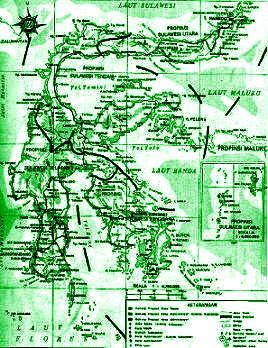
 |
|
|
|---|
| Sulawesi Island has an area of approximately 187,880 km² and a coastline of about 6,000 km. Sulawesi, while not having the richest terrestrial biodiversity of the Indonesian islands, does have the highest proportion of faunal endemics and contains one of the most fascinating and unique fauna found in Indonesia. It also harbors some of the greatest marine biodiversity in nearshore areas in Indonesia and in the world. It contains more endemic mammal species that any other island and is second only to Papua in the number of endemic birds and reptiles (BAPPENAS 2003) This terrestrial fauna includes the unique Babirusa ‘pig’ (Babyrousa babyrussa), dwarf buffaloes (Anoa depressicornis and A quarlesi), Bear Cuscus (Ailurops ursinus) and a divergence of the tiny tarsier primates. The reasons for the unique nature of biotic diversity in and around Sulawesi in part lies with the geological history of Sulawesi. |
 |
|---|
The island’s unique shape results from the submarine collision between the Oriental and Gondwanic geological plates as a consequence of the continuous northern movement of the Gondwanic Plate millions of years ago. This collision forced the welding and buckling of the geologically disparate ‘arms’ of Sulawesi, with the major contact zone for this ‘welding’ process occurring in Central Sulawesi. This puts Central Sulawesi, and Lore Lindu National Park in particular, at the hub of the biodiversity integrity of Sulawesi. This is because it is in Central Sulawesi that the diverse habitat types and richly biodiverse mountains from two previous land masses connect from the north, south and south eastern regional provinces. Most of Sulawesi lies above 500 m in altitude; about 20% of the total land area is above an altitude of 1000 m. The highest mountains ranges are in Central and Northern Sulawesi. The fauna and flora of Sulawesi show a generally closer affinity with islands to the east. The Sulawesi bird fauna is exceptional in that 67% of the species have affinities with Sundaland (Mayr 1944). The mountain flora of Sulawesi is derived from autochonous speciation (endemics) and species that have migrated from other places in the world, mainly from cold climes (van Steenis 1972). Sulawesi butterflies and moths are most strongly associated with the Philippines (Hollaway 1987).
The modern distribution of plants and animals in Sulawesi does not appear to have been greatly impacted by volcanic eruptions such as those that have occurred at Tambora, Sumbawa or Lake Toba, Sumatra. Sulawesi has 11 active volcanoes (Whitten et al. 2002) and the most devastating eruption in Sulawesi in recent times was that of Colo volcano on Una-una Island in Tomini Bay.
Sulawesi has a relatively sparse human population but a diverse and complex ethnic mix. People began converting natural forests to other forms of vegetation in Sulawesi many hundreds of years ago but this process has only accelerated since 1970, when commercial logging, transmigration and estate crop projects began to receive enormous government support. Areas with high agricultural potential have clearly been utilized more than areas with lower potential. Thus, nearly all the wet lowland forest on volcanic soils has been felled, compared with only 10% of such forest on ultrabasic soils. |
|---|
Source : Report on Biodiversity and Tropical Forests in Indonesia, USAID/Indonesia, 2004. Prepared by : (1) Steve Rhee, M.E.Sc. (2) Darrell Kitchener, Ph.D. (3) Tim Brown, Ph.D. (4) Reed Merrill, M.Sc. (5) Russ Dilts, Ph.D. (6) Stacey Tighe, Ph.D. |
 |
 |
|---|
|
|||||||||||||||||||||||||||
|---|---|---|---|---|---|---|---|---|---|---|---|---|---|---|---|---|---|---|---|---|---|---|---|---|---|---|---|
|
|
|||||||||||||||||||||||||||